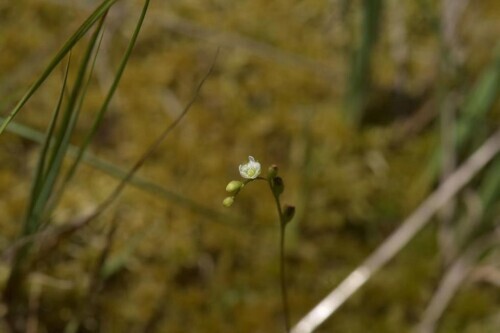Don't look at it as a plant, but the "appetite" is very large, in just 30 minutes, flies, dragonflies, moths and other insects of different sizes have become its "plate food"!
It is the newly recorded species recently discovered in Chongqing - round-leaved thatched grass!

The picture shows the flowers and whole plants of the round-leaved thatched vegetable. Courtesy of Chongqing Wulipo National Nature Reserve Management Office
In late June, during a routine patrol, Zhou Houlin, a senior engineer at Chongqing's Wulipo National Nature Reserve, was pleasantly surprised to find a plant that can prey on insects, round-leaved thatched grass. "In just 30 minutes, insects of different sizes, such as flies, dragonflies, and moths, were seen falling into elaborate red traps with round-leaved thatched vegetables and becoming a feast for thatched vegetables." Zhou Houlin recalled.
According to reports, Drosera rotundifolia is a perennial cordycephalic herb of the genus Thatchedaceae in the family Thatchedaceae. According to the Flora of China, round-leaved thatched vegetables are produced in Jilin and Heilongjiang. It grows in wet montane grasses at altitudes of 900–1000 m, and is found in cold regions such as central and northern Europe, Asia and northern America.
How to "attract bees and attract butterflies", round-leaved thatched vegetables "eat insects" has a high trick. "The genus name Drosera rotundifolia means dewdrops, referring to the expansion of the tip of the glandular hairs at the leaf margins as large as dewdrops. The species adducative word rotundifolia means round leaves. Zhou Houlin explained that the round-leaved thatched grass leaf edge glandular hair at the top of the puffed elephant dewdrops, often showing bright colors, covered with glands, can secrete a mixture of honey and mucus that attract insects and digestive enzymes, the appearance is like a crystal embedded with rubies, can not resist the temptation of insects to feed, but found that they have been stuck, panic in the struggle, the result of the surrounding glandular hairs bent together, sometimes the leaves will be rolled up, sticking more firmly, the beautiful ruby becomes the insect's death trap. When the insects that cannot escape are digested and absorbed by these glandular hairs, when the digestion and absorption are complete, the leaves and glandular hairs are re-expanded, waiting for new prey.
Roundleaf thatch paste vegetables eat moths. Courtesy of Chongqing Wulipo National Nature Reserve Management Office
"The discovery of this species at an altitude of 2,000 meters in Chongqing's Wulipo National Nature Reserve is of great significance." Zhou Houlin introduced that after checking the "Chongqing Vascular Plant Search Table" and "Chongqing Wulipo Nature Reserve Biodiversity" and other data, there is currently only one kind of grassy vegetable in Chongqing, and the round-leaved grassy vegetable has been found for the first time in Chongqing Wulipo and even the entire Chongqing genus, which is a new record species in Chongqing.
It is reported that Chongqing Wulipo National Nature Reserve is located in the northeast of Wushan County, Chongqing, close to Hubei Shennongjia National Park, the reserve is located in the northern edge of central subtropical and the southern end of the warm and humid zone, tropical plants northward migration and temperate plants southward migration have left footprints here. Especially during the Quaternary Ice Age, benefiting from the barrier action of the Qinling, Dabashan and Wushan Mountains, many rare plants have been protected, and 3,001 species of vascular plants have been found in wulipo national nature reserve. At present, Chongqing Wulipo is applying for inclusion as a World Natural Heritage Site. According to the draft resolution published on the official website of the World Heritage Center, Chongqing Wulipo was approved to be included in the proposal for the slight adjustment of the boundary of the Shennongjia World Natural Heritage Site in Hubei Province, China, and the proposal was put forward for the "adoption" of the boundary adjustment, and the final result will be announced at the 44th World Heritage Conference held in Fuzhou, China from July 16 to July 31 this year.
The relevant person in charge of the management office of Chongqing Wulipo National Nature Reserve said that the distribution of round-leaved grass in Chongqing Wulipo National Nature Reserve further proves that the area is one of the important hot spots of biodiversity and a rare gene bank of natural biological species in southwest China. It is of great significance for the study of the origin, evolution, distribution and conservation and utilization of this amazing species.
Source: People's Daily client